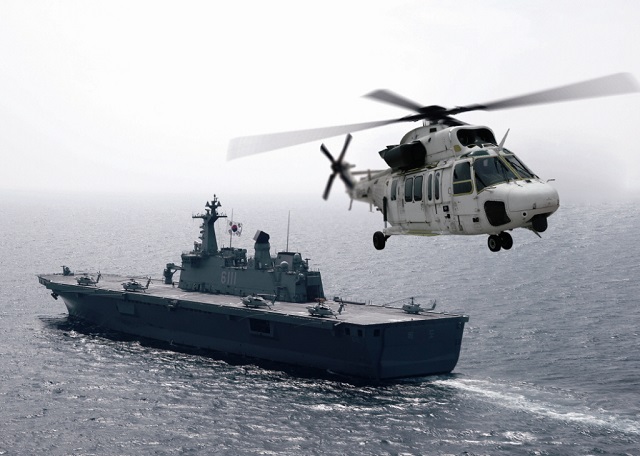| |
|||
| a | |||
Defense
Industry News - South Korea |
|||
KAI
to develop a dedicated version of its Surion helicopter for ROK Navy's
Dokdo class LPH |
|||
KAI,
or Korea Aerospace Industries, Inc. develops the amphibious task helicopter
for the Korea's Marine Corps will run. The Defense Acquisition Program
Administration (DAPA) announced on the 17th that it held its 66th defense
project promotion committee and selected KAI as a priority negotiator
for the development of the amphibious task helicopter system. The project, totaling approximately 800 billion won is designed for securing the helicopter which is able to transport the armed forces, military equipment and supplies to improve the military's 3-dimensional high-speed landing operations performance. |
|||
 KAI selected as a priority negotiator for development of Marine Corps' Surion-amphibious task helicopter to be based onboard Dokdo class LPH Picture: KAI |
|||
KAI will
develop the amphibious task helicopter which the military is able to
run in the optimum condition in the battleship and marine environment,
based on the Surion(a.k.a, KUH), the Korea's first helicopter and plans
to set out for developing it in earnest beginning on July this year.
KAI is scheduled to complete the development of the helicopter at the
end of 2015, targeting for mass production. The DAPA projections that the amphibious task helicopter project will help double the Korean military's independent landing operation capability and also expects that the marine corps' operation radius will be more broadened and its mobility will be further enhanced as well. We have a big expectation for the amphibious task helicopter project, said the Marine Corps. Once the model is developed, the military will make use of it in an efficient manner at both in wartime and in peace time and run those models to be ready for diverse operations. KAI plans to develop the Surion-based derivative helicopter version and replace the existing Korea's military and public copters with a new one, stepping forward, attempting to export to foreign countries. KAI forecasts that the demand for the Surion-class military and public helicopters, such as the amphibious task helicopter to be developed this time, the police helicopter for which the company concluded with the Korea Police Agency in 2011, MEDEVAC helicopter, and the helicopters for Korea Coast Guard, Korea Fire Department and Korea Forest Service, in Korea for the upcoming 20 years will reach approximately 400 units. Also, KAI predicts that the company could possibly take a share of roughly 30%, or 300 of the total 1,000-plus helicopter demand in the 25-year period to come and export those quantity. The foreign-made copters which the Korea's military and government agencies run are replaced with the Surion helicopters and other diverse derivative versions, a huge drainage of foreign currency could be prevented and the technological prowess and price competitiveness would be also enhanced, expanding the exports, said an official at KAI. KAI predicts that once the diverse derivative versions, including the Surion-based amphibious task helicopters are successfully developed, the local aviation industry would evolve and the large-scale industrial ripple effect and job creation could take place as well. The aviation industry is the cluster of the most high-tech convergence industries and its industrial ripple effect is pretty much large. Also, it is the creative economy industry which makes it possible to create large-scale high-grade jobs, told KAI. If the Surion-version derivative helicopter development, and the replacement and exports of the foreign-made helicopters are smoothly made, we could see a production inducement effect amounting to approximately 15 trillion won and a more than 160,000 job creations effect for the project period. |
KAI to develop a dedicated version of its Surion helicopter for ROK Navy's Dokdo class LPH
- Posted On










